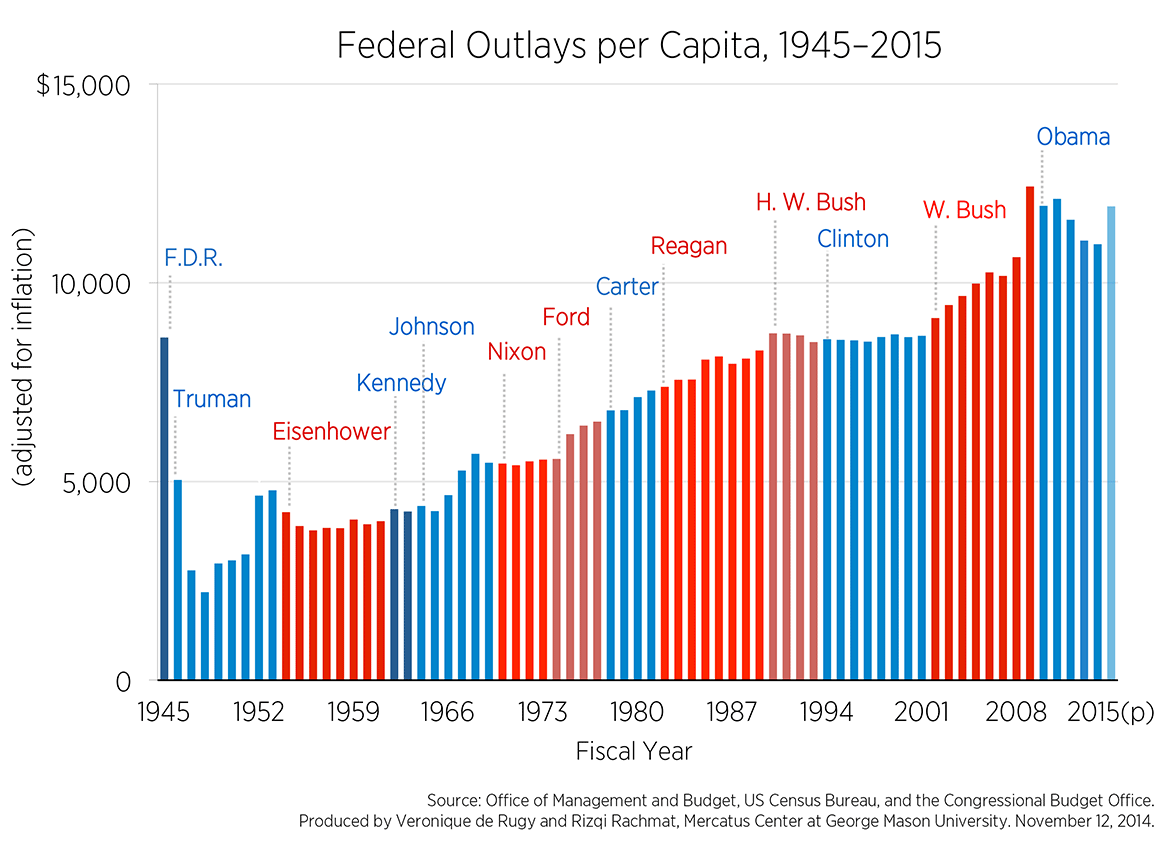Hey Libertarians: Prepare To Be Disappointed in Trump's 10-Year Budget Plan
He'll cut less than we want, exaggerate economic growth, and pretend it all balances out in 2028.

Tomorrow should be exciting: It's the day that Donald Trump will release his first full budget plan, which will carry with it a 10-year window over which 3 percent annual economic growth will be restored and outlays and revenues will magically match up in a way they haven't since fiscal 2001.
Yet if past is prologue—and by past, I mean the budget plans offered over the years by the George W. Bush and Barack Obama administrations—don't expect a document worth the pixels it is printed with.
Bush pushed tax cuts through and while revenue dipped at first, it started climbing back up after a few years, he ultimately raised real federal outlays by about 50 percent over his two terms. He was never credible, then, either on pushing for a balanced budget and, as important, in reducing the spending of government and hence its impact on all of our lives (as Milton Friedman used to say, government spending is the ultimate measure of government influence over the economy; whether spending is paid-for or based on borrowed money, it represents a tax on us now or in the future).
Barack Obama's fiscal trajectory is a little more complicated. Via his stimulus plan and expansion of various bailouts, he helped Bush grow fiscal 2009 spending to record levels. But after the 2010 midterms, he lost his congressional majority and per capita spending actually dropped year-over-year before resuming its seemingly inexorable climb. It's hard to believe that Obama had actually campaigned in 2008 on a net spending cut because he never even made the lamest feint in that direction. And of course, the national debt soared on his watch—and the very notion of passing a budget rather than using continuing resolutions sunk to the bottom of the tidal basin.
So what might we expect from Trump's budget plan? His earlier iteration of his "skinny budget" only covered discretionary spending (a category that accounts for outlays that must be renewed every year and comprises about one-third of all federal spending) didn't cut overall spending. Yes, it proposed some double-digit trims to various programs and agencies, but it funneled all savings into a bigger defense budget.
Since 2008, overall spending levels have been north of 20 percent of GDP, which is considerably higher than the historical average for the last 50-plus years of the postwar 20th century. There's no reason to believe that Trump will put a stop to that, especially since he has promised not to touch the major drivers of government spending, Social Security and Medicare. Neither of those plans is self-sustaining, so each require larger and larger subsidies from taxpayers, especially as more and more baby boomers hit the Depends years. While USA Today and others are reporting that Trump will call for massive cuts to Medicaid, most of that will come from recent increases tied to expansions under Obamacare. Yet a huge amount of Medicaid actually goes to pay for longtime care for elderly people and won't be affected by Trump's likely trims.
White House Budget Director Mick Mulvaney has said the administration wants to reach 3% levels of growth. While that's the historic average, experts say 3% growth will be difficult to achieve because of a slowdown in the growth of labor, capital and productivity. The main reason for that is the aging population — which is also driving the projected increases in spending for Social Security and Medicare.
As Nicholas Eberstadt notes, between 1946 and 2000, annual per-capita economic growth averaged 2.3 percent, already below Mulvaney's 3 percent. Since 2000, however, the United States has been looking at average per-capita growth of less than 1 percent a year. Sure, tax cuts might help kickstart the economy to some degree, but the plain fact is that there's every reason to think any increases in activity will be more than swallowed up by automatic increases in spending tied to Medicare, Social Security, and probably defense spending. From USA Today's crystal-ball article:
Hardline conservatives have been pushing for a balanced budget, and Mulvaney has said he wants to get there in 10 years. But even he acknowledged that's difficult. Deficits are projected to more than double over the next decade. Experts, such as those at the Committee for a Responsible Federal Budget, say they will be on the lookout for "gimmicks" that would make a path to a balanced budget look easier than it is. Those include: overly optimistic projections of economic growth, unspecified savings and unrealistic proposals.
Here's hoping that budget hawks continue not just to push for a balanced budget, but that they do so by pushing for spending cuts. There is a generational storm on the horizon, as Millennials will be footing the bill for unsustainable and immoral old-age entitlements that benefit relatively older and wealthy Americans at the expense of younger and poorer ones. Cutting spending will not only reduce long-term deficits and debt, which tend to have a smothering effect on economic growth, but there is ample reason to believe that reductions in government spending spur private-sector activity.
Tune in tomorrow for specific responses to Trump's budget plan.


Show Comments (23)